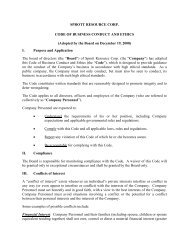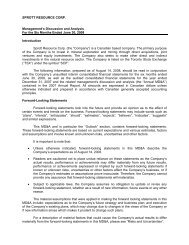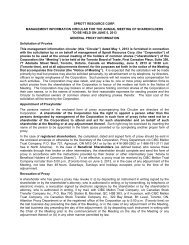AIF - Sprott Resource Corp.
AIF - Sprott Resource Corp.
AIF - Sprott Resource Corp.
Create successful ePaper yourself
Turn your PDF publications into a flip-book with our unique Google optimized e-Paper software.
licences, and permits for varying periods, and on conditions set forth in provincial legislation including requirements to<br />
perform specific work or make payments. Oil and natural gas located in such provinces can also be privately owned and<br />
rights to explore for and produce such oil and natural gas are granted by lease on such terms and conditions as may be<br />
negotiated.<br />
Environmental Regulation<br />
The oil and natural gas industry is subject to environmental regulation pursuant to a variety of provincial and federal<br />
legislation. Such legislation provides for environmental protection and applies restrictions and prohibitions regarding<br />
disturbances and releases or emissions of various substances produced or utilized in association with certain oil and gas<br />
industry operations. In addition, such legislation requires that well, pipeline and facility sites be abandoned and reclaimed<br />
to the satisfaction of provincial authorities. Environmental laws may impose remediation obligations with respect to a<br />
property designated as a contaminated site upon certain responsible persons, which include persons responsible for the<br />
substance causing the contamination, persons who caused release of the substance and any past or present owner,<br />
tenant or other person in possession of the site. Compliance with such legislation can require significant expenditures<br />
and a breach of such requirements may result in suspension or revocation of necessary licenses and authorizations, civil<br />
liability for pollution damage, the issuance of clean-up orders and the imposition of material fines and penalties.<br />
Environmental legislation in the Province of Alberta has been consolidated into the Environmental Protection and<br />
Enhancement Act (Alberta) (the “EPEA”), which came into force on September 1, 1993, and the Oil and Gas<br />
Conservation Act (Alberta) (the “OGCA”). The EPEA and OGCA impose certain environmental standards, reporting and<br />
monitoring obligations, responsibilities and penalties which may be significant for violations. In 2006, the Alberta<br />
Government enacted regulations pursuant to the EPEA to specifically target sulphur oxide and nitrous oxide emissions<br />
from industrial operations including the oil and gas industry. In addition, the reduction emission guidelines outlined in the<br />
Climate Change and Emissions Management Amendment Act came into effect on July 1, 2007 (“CCEMAA”). Under this<br />
legislation, Alberta facilities emitting more than 100,000 tonnes of greenhouse gases a year must reduce their emissions<br />
intensity by 12 percent. Industries have three options to choose from in order to meet the reduction requirements outlined<br />
in this legislation: (i) make improvements to operations that result in reductions; (ii) purchase emission credits from other<br />
sectors or facilities that have emissions below the 100,000 tonne threshold and are voluntarily reducing their emissions; or<br />
(iii) contribute to the Climate Change and Emissions Management Fund (the “Fund”). Industries can either choose one of<br />
these options or a combination thereof. Pursuant to CCEMAA and the Specified Gas Emitters Regulation, companies<br />
were obliged to reduce their emission intensity by 12 percent by March 31, 2008. It is reasonably likely that the trend<br />
towards stricter standards in environmental legislation and regulation will continue.<br />
On January 24, 2008, the Alberta Government announced a new climate change action plan that will cut Alberta’s<br />
projected 400 million tonnes of emissions in half by 2050. This plan is based on three areas: (i) carbon capture and<br />
storage, which will be mandatory for in situ oil sand facilities that use heavy fuels for steam generation; (ii) energy<br />
conservation and efficiency; and (iii) greening production through increased investment in clean energy technology,<br />
including supporting research on new oil sands extraction processes, as well as the funding of projects that reduce the<br />
cost of separating CO 2 from other emissions. In addition to this action plan, the Provincial Energy Strategy unveiled on<br />
December 11, 2008 is expected to, among other things, support the upgrading, refining and petrochemical clusters<br />
existing in the Province, market Alberta's energy internationally, review the emission targets and carbon charges applied<br />
to large facilities, and promote the innovation of energy technology by encouraging investment in research and<br />
development.<br />
In December 2002, the Government of Canada ratified the Kyoto Protocol (“Protocol”). The Protocol called for Canada to<br />
reduce its greenhouse gas emissions to 6 percent below 1990 “business-as-usual” levels between 2008 and 2012. Bill C-<br />
288, which was intended to ensure that Canada meets its global climate change obligations under the Protocol, was<br />
passed by the House of Commons on February 14, 2007. On December 12, 2011, Canada formally withdrew from the<br />
Protocol opting to keep in line with U.S. action in pursuing a regulatory approach that would impose sector by sector rules.<br />
On April 26, 2007, the Federal Government released its Action Plan to Reduce Greenhouse Gases and Air Pollution (the<br />
“Action Plan”) also known as ecoACTION which includes the regulatory framework for air emissions. This Action Plan<br />
covers not only large industry, but regulates the fuel efficiency of vehicles and the strengthening of energy standards for a<br />
number of energy using products.<br />
15





